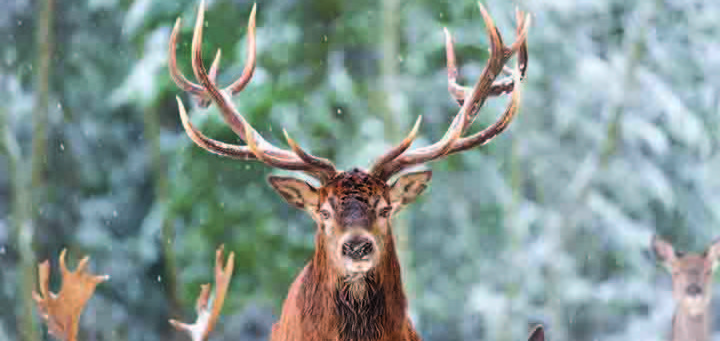
Conversations
Urban Wildlife: How local wildlife is reacting to urban sprawl and what to do about it
November, 2019
Garnet Melnyk still remembers the food that was left out in a park in St. Albert’s Deer Ridge neighbourhood a few years ago. “There was somebody feeding coyotes, if you can believe that,” says the peace officer supervisor. “They felt sorry for the coyotes.” Good intentions, no doubt, but they ended with wildlife officers tracking down the offending Samaritan and asking them politely to cease and desist.
“You can’t do this,” Melnyk says, still incredulous as he recalls the incident. “You’re creating a problem, and you’re desensitizing these wild animals.”
Then there was local resident Elise Graham, who found the behaviour of the coyotes that visited her home this past summer to be quite amusing. Her fence was down for a few months, and her property backs onto the Botanical Garden where coyotes often roam up from the river valley. “One was coming right up to my back door and taking the mice that our cats would kill and leave. At least he got along with my cats!”
These incidents may be useful reminders of the extent to which we share our towns and cities with wild animals of all sizes—as well as highlighting how out-of-touch many of us are when it comes to dealing with the wildlife around us. Yet, as we become even more urbanized, the problem of how we can coexist with our animal neighbours is a complex one that defies easy solutions, and may even end up changing how we design our cities.
Bright Lights, Big City
For example, there was the tragic case of a black bear that had to be euthanized in May, after it was wandering around St. Albert. During this past summer there were a number of isolated wild animal sightings in communities surrounding Edmonton including bears, cougars, and even moose.
The pace of urban growth in central Alberta is a big reason why human-wildlife encounters occur as often as they do. Through good economic times and bad, Edmonton and its surrounding communities have exploded in size. Since the 1991 census, St. Albert has added some 25,000 people.
The building of roads, buildings and neighbourhoods, as well as agricultural development, has put a great deal of pressure on wildlife, however. Animals generally don’t stick around in just one place; rather, they tend to move between natural areas in search of shelter and food, often using the cover of night or vegetation to remain hidden. Urban environments interfere with this by eating up natural areas and breaking up wildlife corridors. They can also pose a direct threat to wildlife—human-wildlife conflicts are much more likely to end badly for the animal, and obstacles like major roadways pose lethal hazards for animals simply trying to get from one place to another.
Two Worlds Colliding
Fortunately, it’s an issue that city officials and planners in the region are increasingly aware of. “The major corridor that we have is the Big Lake-Sturgeon River valley,” says Melissa Logan, environmental coordinator with the City of St. Albert. Like other river valleys, the Sturgeon is crucial as a sort of highway for animals moving between natural areas and habitats. Unfortunately, it also passes through one of the province’s largest cities, and decades of development along the river’s banks have reduced its ability to provide adequate cover for animals passing through.
While the loss of natural cover is one factor bringing wildlife out under the glow of streetlights, another is the sheer amount of food that cities offer. Coyotes are a good example. Adaptable and intelligent, they’re masters at living on the fringes of city life. As omnivores that’ll eat almost anything, their varied diets include fruit and berries, small mammals and food scraps left behind—intentionally or otherwise—by people. If you haven’t noticed, these are all food sources readily available in or near urban centres.
“They’re creatures of opportunity,” says Melnyk. “They’ll eat berries and grass, they’ll go through people’s garbage, they’ll go into backyards and eat the fruit off the trees.”
Coyotes can even be attracted to pet feces and bird seed, and will sometimes climb trees to get at bird feeders. And, more gruesomely, they are known to go after unattended cats and small dogs.
Creatures Great and Small
Tove Reece, Executive Director with animal rights organization Voice for Animals, also blames urban sprawl on the increase of wildlife in cities. “Animals are being squeezed out of their natural homes,” he says.
“It should not come as a surprise that they are looking for space wherever they can find it, even in busy, dangerous and often hostile cities. I think it’s important to remember that wildlife has not come into the city to attack anyone or to cause trouble but simply looking for food and a place to survive. Most wild animals are not dangerous and would rather avoid people than have an encounter or confrontation.”
In the Capital Region, large wildlife can
include moose, deer, coyote, cougar, and lynx, but can depend upon the season
and breeding time. However, most wild animals will avoid direct contact with
humans, but can sometimes make their presence known in the city through the parks
and trail system, or because people have made their way into the animals’
natural habitat. The main advice from experts
is avoid approaching or
handling wildlife.
A general rule is the larger the animal, the larger the risk. “Moose pose a higher level of risk to the public than most other species,” says Fish and Wildlife Officer Dennis Prodan, who is with the Edmonton district office, which handles calls concerning large wildlife. “A moose that is stressed, a bull moose in the fall rut, or a cow moose protecting her young may be easily provoked into an attack, which is a risk to individual and public safety. A motor vehicle collision with a large ungulate can also be serious. Any large predator should be respected and given their space. When stressed, startled, or threatened they may become defensive or aggressive.”
What Cities and Urban Residents Can Do
Given all the hazards that animals face as they attempt to navigate urban areas, it begs the question of what we can do better to mitigate the harm to animals. Some municipalities might look to our mountain parks for inspiration. In Banff National Park, the creation of 22 underpasses and two overpasses for wildlife has helped greatly cut down on vehicle-animal collisions there—by up to 90 percent in some sections of the park, research has shown.
Of course, wildlife bridges and underpasses are much more feasible in rural areas or on the fringes of cities, areas that haven’t been fully built up yet. A number of these exist in and around Edmonton, many of them in industrial parks or along the Anthony Henday freeway. In St. Albert, the idea hasn’t quite caught on yet, but it may do so as the city continues to rapidly grow. For example, specialized culverts have been put in place under Ray Gibbon Drive west of St. Albert, though the city hasn’t studied to what extent they’re being used and by what animals.
Ultimately, it may come down to making our communities greener: incorporating more connected green spaces, protecting and expanding existing natural areas, and most of all, better educating the public about wild animals and their behaviour. t8n
Lower the Risk
“The best thing to do to avoid conflicts with wildlife is prevention,” says Fish and Wildlife Officer Dennis Prodan. “Make your property unappealing to wildlife and manage any attractants on your property.” Here is some of his practical advice for anyone concerned about coming into contact with urban wildlife and keeping critters away from their homes.
Never feed wildlife. Wildlife feeding on food from people and human-use areas not only prevents wildlife from getting nutrition from natural food sources, it teaches wildlife to associate people with food. This can lead to problematic, even dangerous, situations that may result in human injury and/or wildlife being destroyed.
Never approach wildlife. It may be stressful for wildlife when someone enters their territory. Over time, wildlife can become accustomed to people, increasing the risk of negative human-wildlife encounters. Always respect the “personal space” of wildlife to help them stay wild. Also keep in mind that bats, skunks, and foxes are carriers of rabies and, if seen acting oddly, must be avoided, even if your intention is to help.
Keep your dog on a leash.
Even well-trained dogs cannot fight their instinct to bark and chase. This can
stress wildlife and cause them to dart into traffic or lead to other unsafe
situations such as a defensive attack.
Keep your cats indoors. Cats allowed to roam make easy prey for coyotes and foxes. Coyotes and foxes that learn easy prey can be found in a neighbourhood will return to that same area for future meals, creating potential new problems for the community. Keeping cats indoors also helps protect the native songbirds that frequent the city.
Keep your garbage in a secure container with a lid. Make sure your garbage containers are in good condition. Household waste appeals to wildlife as a source of easy meals.
Remove food and shelter that attracts wildlife to your property. Clean your yard of all garbage, pet foods, bird seed, and fallen fruit and berries that can serve as a food source for wildlife. Potential shelter, such as the spaces under decks, patios, and outbuildings, should be closed off with durable wire mesh.
Drive carefully. Slowing down when driving near parks, river valleys, golf courses, and other green spaces lessens the likelihood of collisions with wildlife.
Teach your children about wildlife in the city. Children should be taught to make safe decisions and respect wildlife by never feeding or approaching wildlife, putting garbage into garbage cans, not running away when they see coyotes or foxes, and keeping their pets leashed and supervised.
Alberta Fish and Wildlife (Edmonton)
780-427-3574
Northern Alberta Wildlife Rescue & Rehabilitation (WILDNorth)
780-914-4118













